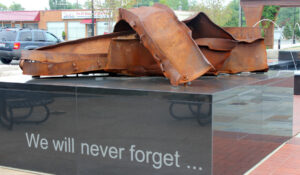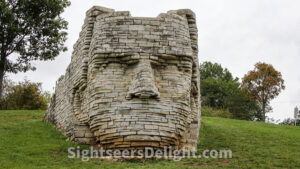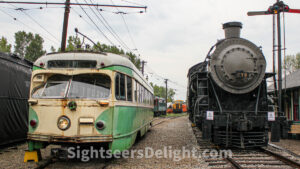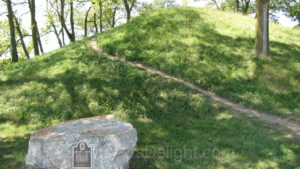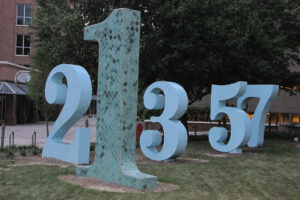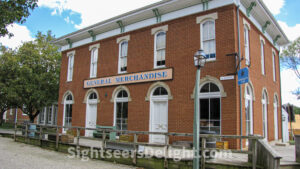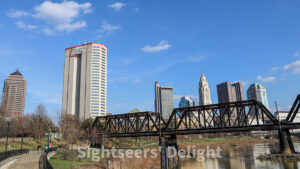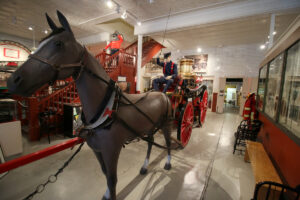The Granville Opera House was destroyed by fire on April 7, 1982. The historic edifice was built in 1849 as a Baptist Church and moved to a location at the corner of Broadway (Ohio Route 661) and Main Street in 1882. The church tower’s bell is still on display in a park built on the site of the Opera House. The bell first rung on June 29, 1872, to announce the death of the Reverend Samson Talbot, Denison University’s fifth president. The bell was also know for sounding on the hour and as the fire alarm.
43023
In the heart of Hilliard, a bucolic Columbus suburb, stands what is said to be one of the largest Sept. 11 memorials. First Responders Park Memorial is dedicated to first responders nationwide and aims to remind visitors that no matter where they live, they have a stake in what happened on Sept. 11. One of the memorial’s features is a trio of granite walls inscribed with the names of those who lost their lives in the attack. In addition, steel from the World Trade Center was incorporated into the memorial.
43026
Home to more than 10,000 animals representing over 600 species from around the globe, the Columbus Zoo and Aquarium leads and inspires by connecting people and wildlife. The Zoo complex is a recreational and education destination that includes the 22-acre Zoombezi Bay water park and 18-hole Safari Golf Course. The Columbus Zoo and Aquarium also operates The Wilds, a 10,000-acre conservation center and safari park located in southeastern Ohio. The Zoo is a regional attraction with global impact; annually contributing $4 million of privately raised funds to support conservation projects worldwide.
43065
Leatherlips is one of Ohio’s great historic legends. He was executed in on June 1, 1810, though the precise location is open to some debate. To honor the great Wyandot Native American Chief, the Dublin, Ohio, community in 1990 unveiled a 12-foot high sculpture of Leatherlips’ head. Designed by Boston artist Ralph Helmick and located in Scioto Park, the portrait was made using stacked native limestone. The top is open with stacked stones extending back along its sides, making for a popular picture stop.
43065
Founded in 1948 and incorporated in 1950, the Ohio Railway Museum is among the oldest railroad museums in the country. The museum operates over the former Columbus, Delaware, and Marion Railway right-of-way. One of its key locomotives on display is Norfolk & Western No. 578, an American Locomotive Co. 4-6-2 “Pacific” E2a steam locomotive. Built in March 1910, the steamer is said to be one of the last surviving E2a locomotives built for the Norfolk and Western Railway Co.
43085
Shrum Mound was likely built between 800 BC and 100 AD. At approximately 100 feet in diameter and 20 feet tall, Shrum Mound is said to be “one of the last remaining conical burial mounds” in Columbus. The grass-covered mound features a path leading to the top. The mound is located in Campbell Park, named for former Ohio Gov. James E. Campbell who later served as president of the Ohio Archaeological and Historical Society. The mound derives its name from the Shrum family, which in 1928 donated the land where the mound sits to the Ohio Historical Society.
43204
Arizona artist Barbara Grygutis created the Garden of Constants, located at the College of Engineering. The garden, installed in 2004, features two main elements: 10 large number sculptures numbers and symbols set into the pavement. The Ohio State University Percent for the Arts commissioned the sculpture. The work is located outside of Dreese Lab, home to the Computer and Information Science and Electrical Engineering departments.
43210
The Ohio Historical Society operates the Ohio Village living history museum. The 15-acre museum, which opened on July 27, 1974, aims to give a firsthand view of life in Ohio during the Civil War. The village is home to 22 buildings, including a mix of reproductions and historic structures relocated to the site.
43211
Battelle Riverfront Park is a 4.1-acre park near Columbus City Hall in downtown Columbus, Ohio. The park was established in 1983. It is named after Gordon Battelle and was funded by the Battelle Memorial Institute.
43215
The Central Ohio Fire Museum & Learning Center opened in 2002 inside the restored historic Columbus Engine House (No.16) dating to 1908. In addition to historic engines and equipment, the museum aims to educate visitors about the dangers of fire and features a Safety Kitchen and a Safety Bedroom showing potential hazards and how to escape in an emergency.
43215

